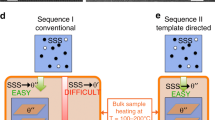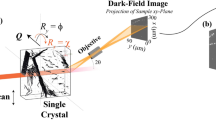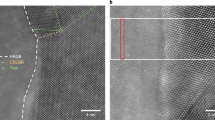Abstract
CALCIUM fluoride occurs in Nature as the crystal form known as fluorite. It can, however, be grown artificially as single crystals, and when doped with suitable impurities it is widely used as a laser material1,2. For this purpose, calcium fluoride is usually doped with rare-earth impurities or uranium and grown by either the Czochralski3 or Stockbarger4 techniques. The Czochralski technique is inherently a high temperature-gradient method of growth, in which the crystal is pulled directly from the melt, whereas the Stockbarger process, in which the molten material is crystallized inside a crucible in a controlled manner, involves much lower temperature gradients. During etching investigations on crystals grown by these techniques, it was noticed that certain similarities and differences existed in the dislocation arrangements induced by the method of growth, and that some of these could be modified by subsequent annealing. These features are described and compared with the dislocation arrays observed in crystals of other materials grown using the Czochralski technique.
This is a preview of subscription content, access via your institution
Access options
Subscribe to this journal
Receive 51 print issues and online access
$199.00 per year
only $3.90 per issue
Buy this article
- Purchase on Springer Link
- Instant access to full article PDF
Prices may be subject to local taxes which are calculated during checkout
Similar content being viewed by others
References
Guggenheim, H., J. App. Phys., 32, 1337 (1961).
Guggenheim, H., J. App. Phys., 34, 2482 (1963).
Czochralski, J., Z. Phys. Chem., 92, 219 (1918).
Stockbarger, D. C., Rev. Sci. Instrum., 7, 133 (1936).
Roy, C., Ph.D. thesis, Imperial College (London) (1962).
Pfann, W. G., and Lovell, L. C., Acta Met., 3, 512 (1955).
Billig, E., Proc. Roy. Soc., A, 235, 37 (1956).
Rosi, F. D., R.C.A. Rev., 19, 349 (1958).
Cockayne, B., Robertson, D. S., and Bardsley, W., Brit. J. App. Phys. (in the press).
Cockayne, B., and Hollox, G. E., Phil. Mag., 9, 911 (1964).
Nassau, K., and Broyer, A. M., J. Amer. Cer. Soc., 45, 474 (1962).
Author information
Authors and Affiliations
Rights and permissions
About this article
Cite this article
COCKAYNE, B., ROBERTSON, D. & STRAUGHAN, B. Calcium Fluoride : Slip and Polygonization during Crystal Growth. Nature 203, 1376–1378 (1964). https://doi.org/10.1038/2031376a0
Issue Date:
DOI: https://doi.org/10.1038/2031376a0
This article is cited by
-
X-ray topographic analysis of dislocation line defectsin calcium fluoride crystals
Bulletin of Materials Science (1982)
-
Single-crystal growth of sapphire
Journal of Materials Science (1967)
-
Yttrium aluminium garnet single crystals: Polishing, etching and dislocation distribution
Journal of Materials Science (1966)
Comments
By submitting a comment you agree to abide by our Terms and Community Guidelines. If you find something abusive or that does not comply with our terms or guidelines please flag it as inappropriate.



